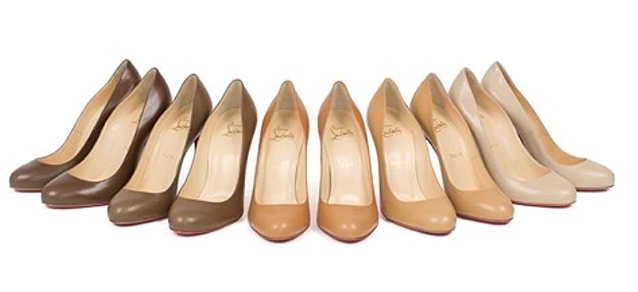Women, Shoes and Inclusion
I picked up the Age Sunday magazine (9/08/2015) and glanced at the ‘ups & downs’ column, a great visual that depicts what is trending up and what is not. In the ‘up’ piece, my eye focussed in on ‘nude’ shoes and Christian Louboutin’s expansion of the range to include more colours. ‘Nude’ ranges stereotypically are a light beige colour, which excludes all the rest. For a moment, whilst reading it, I revelled in the realisation of a change in mindset and simultaneously understood why I have never been able to own a pair of these ‘nude’ shoes. It has never matched my skin tone. Then my mind spiralled into all sorts of ‘nude’ items I have never been able to purchase, foundations (make-up), ‘skin colour/nude’ stockings, nude nail polish, those nude/’invisible socks’ to wear in high heels (not so nude for me!) and even plasters!
Bravo Christian Louboutin! I googled him and read a myriad of articles championing his cause. If only he could make it more affordable for the many colours of women his shades of shoes are made for.
On a deeper level, it caused me and a few other colleagues to really assess how intricately entrenched and somewhat unconscious these differences of race and ethnicity are. Until this weekend, I would shop for myself thinking my skin colour was hard to match, not questioning why brands did not accommodate for a wider range of diversity. A moment of clarity and a key message for me to take to my two daughters who are two different shades of ‘nude’ and to the various Women forums (business councils and mentoring programs) I am involved in.
Unconscious Bias
What is in play here are two levels of unconscious bias (meaning a prejudice or assumption we make about another person based on a common stereotype rather than a thoughtful judgement). Major brands continue to produce ‘nude’ ranges that are really light beige, able to be worn authentically only by Caucasians and secondly many consumers like me think they ‘don’t match’ the colour charts. Both unconsciously continuing the bias rather than questioning the colour charts!
This goes to the heart of cross-cultural re-education, tapping into what we define as ‘beige/nude’ or the norm. Drawing on various cross-cultural business conversations and relating this shoe colour dilemma here is a scenario: Where Western firms are leading interactions, there is often an unconscious deference to this ‘nude=light beige’ view of thinking, or “let’s stick to what we know” thinking. Eastern partners often back down to this confidence, knowing full well that “nude=a spectrum of colours”, however they are reluctant to challenge this overtly and may even enthusiastically agree that “nude=light beige” to avoid conflict.
Talking or writing about it is an exercise in futility though. As a developed nation, we are well aware of the theories of unconscious bias. However here we sit with race, ethnic and gender bias alive and well. We need acknowledgement AND action. So here are a few scenarios with recommendations to action, to make it easier when tackling race and ethnic bias.
In cross culturally different business contexts, an expatriate relocation, working with an offshore team, a cross border merger or acquisition consider the following (all of these have been used successfully by Australian leaders):
• In a meeting, the Australian leader will often lead, asking questions about progress and get immediate silence. Rather than fill the silence and answer their question, this leader should rephrase the question and just wait. The unconscious bias to break is: interpreting silence from an Asian partner to mean a lack of understanding or that there is no answer to the question.
• When asking for an update on critical issues from Asian partners, Australian leaders might get a barrage of different tasks that have been performed, shared to show how hardworking Asian team members have been. Unconsciously there may be a judgement forming of Asian partners being disorganised or maybe skirting the critical issues, working unproductively. Asking clear questions in the meeting, sending key pre-prepared questions via email or meeting with a key stakeholder in Asia beforehand to honestly convey how the overwhelming detail deviates from the critical information; can move agenda items forward. The critical tasks may have been done – the gap might be in the concise, direct communication of them.
• Australian female leaders have experienced that even as the most senior person on calls to Asia there seems to be more eye contact, questions and approval seeking from junior male colleagues. A winning strategy has been to get these male colleagues to defer the authority and approval seeking back to the female western leaders, securing them hierarchically as the highest authority. This unconsciously breaks a stereotypical bias held in some Asian firms of women being inferior.
The challenge is in continually redefining beige being nude within a cross-cultural business and gender diverse context – the world has too many colours to benefit from.
Feel free to share, like and comment professionally.

Div Pillay is a cross cultural expert and Co-Founder of MindTribes – a Telstra Business Award Finalist & Westpac Businesses of Tomorrow company that, optimises performance by realigning people and leaders, when working across different country and organisation cultures.
